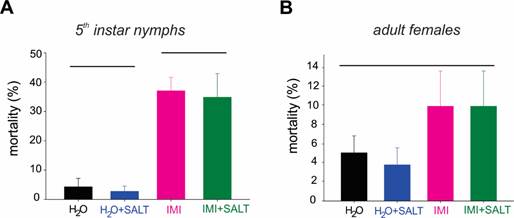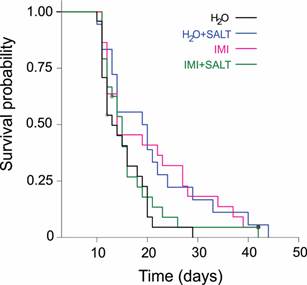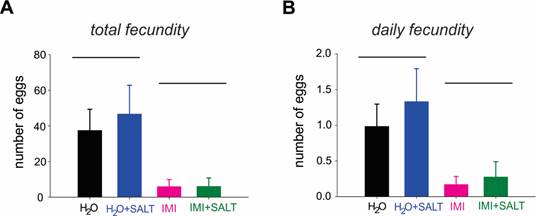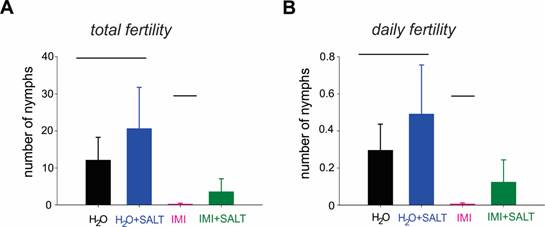Introduction
The soybean, Glycine max L., presents great economic importance in Brazil and the productivity of these plants is severely affected by insect pest attacks. These insects, besides decreasing productivity, substantially raise the cost of production due to pest management strategies which are of unquestioned need (Ávila and Grigolli, 2014; Peterson et al., 2018).
Among other insect pests, the herbivory attacks delivered by a “stink bug complex”, which includes over three species of stink bugs, is considered one of the major barriers to the development of soybean crop fields in Brazil and other countries (Da Graça et al., 2016). The management of such pests, for instance, the Neotropical stink bug, Euchistus heros (Fabr.) (Hemiptera: Pentatomidae) heavily relies on the use of synthetic pesticides, which includes, organophosphates, pyrethroids, organochlorides (endosulfan) and neonicotinoids (Panizzi et al., 2012; Tuelher et al., 2018).
The neonicotinoids, acting as agonists of acetylcholine receptors (Buckingham et al., 1997; Nauen et al., 2001), are among the most used pesticides in soybean fields and are frequently used by Brazilian farmers due to their high efficiency (Pazini et al., 2019; Castellanos et al., 2019). Furthermore, a common practice in Brazilian soybean fields consisting of adding sodium chloride (NaCl) at the concentration of 0.5% (w/v) to insecticide solutions is, supposedly, believed to decrease the quantities of pesticide by half (50%) without losing efficiency (Corso, 1990; Panizzi et al., 2007; Ávila and Grigolli, 2014).
It is believed that NaCl acts like a phagostimulant or arrestant molecule, which increases the insect contact (exposure period) with the pesticide solution or dry residues (Corso, 1990; Sosa-Gómez et al., 1993; Niva and Panizzi, 1996; Corso and Gazzoni, 1998). The existence of salt action on the pentatomid stink bugs nervous system was confirmed by the presence of neuroreceptors sensitive to low concentrations of sodium chloride, causing a simultaneous attraction (Gr5a receptors) and deterrence (Gr66a receptors) behavior (Yarmolinsky et al., 2009).
A couple of recent works tried to better elucidate the actions of imidacloprid (Haddi et al., 2016; Santos et al., 2016), but the synergic effects of NaCl added to some pesticides are not fully explained and still need further investigations that address the reasons underlying the aforementioned synergism as well as the reasons why it occurs only with some pesticides.
The use of biological control and integrated pest management programs in soybean fields, especially for the control of Anticarsia gemmatalis (Lepidoptera: Noctuidae), and some other stink bugs have also had favorable results (Ramiro et al., 1986). Predatory stink bugs, e.g., Podisus nigrispinus, Hemiptera: Pentatomidae, naturally occur in the Neotropical region (in many crop fields, including soybean) and are considered very important natural enemies of defoliator caterpillars (Pires et al., 2006, Holtz et al., 2019).
These predatory insects delivery their free of costs ecological services aiding in the management of soybean pests and have the potential to be introduced to enhance the power of other pest control strategies, in cases of augmentative biological control uses (Desneux et al., 2007; Batalha et al., 2012; He et al., 2012; Naranjo et al., 2015; Bueno et al., 2017). However, the impacts of commonly used conventional pesticides and their enhancers (e.g., NaCl) have been completely neglected for predatory stink bugs. Hence, it is of extreme importance to study the potential selectivity/compatibility of these compounds to natural enemies.
Thus, this study aimed to investigate the potential effects including side effects on the reproductive abilities of the neonicotinoid imidacloprid associated to NaCl which is highly recommended for controlling the Neotropical stink bug E. heros on the predatory stink bug P. nigrispinus.
Material and Methods
Insect rearing
Podisus nigrispinus. Eggs of Podisus nigrispinus were field-collected and kept in Petri dishes (9cm diameter) with distilled water (soaked cotton wool) to provide humidity. After egg hatching, immature stages were transferred to cages (30x15cm) made by wood (frame) and veil cloth (coverage). They were fed with Tenebrio molitor L. (Coleoptera: Tenebrionidae) pupae. Additionally, Eucalyptus spp. leaves were provided by setting a small branch inside the cage. The stem of the branches was kept inside a glass flask (15 mL of volume capacity) filled with water to keep them hydrated. The stock colony was kept under controlled conditions of temperature (25 ± 2°C), photoperiod (12h scotophase), and humidity (70 ± 10%) (Lemos et al., 2003).
Bioassays
Acute toxicity against the predatory stink bug Podisus nigrispinus. Newly emerged fifth instar nymphs and adult females (< 72 hours) were exposed to dry residues of the recommended field rate (4.2µg a.i./cm²) of imidacloprid to control E. heros in soybean fields (MAPA, 2018) with or without the addition of NaCl 0.5% (w/v). Distilled water added or not with NaCl was used as the control. Insecticide exposure was achieved by contact with glass surface impregnated with dried residues. Briefly, 2mL of insecticide solution of distilled water were applied to 250mL transparent glass jars (EME Equipment, Paulicéia, SP, Brazil), which were maintained under rotation until dry using a heavy‐duty rotator (Roto‐Torque model 7637, ColeParmer, Vernon Hills, IL, USA) to coat the inner walls of the jars with insecticide residue. The upper portion of each container was coated with Teflon PTFE (DuPont, Wilmington, DE, USA) to prevent insects from escaping. Ten insects, nymphs or adult females, were set inside the glass flasks and the exposure period was 48 hours. Insects were considered dead when did not move or cannot walk a distance corresponding to double the size of their own body for one minute. The experiments were kept under laboratory-controlled conditions of temperature 25 ± 2°C relative humidity 60 ± 10% and L: D photoperiod of 14:10h. Was performed at least nine replicates for each P. nigrispinus stage and treatment.
The survivor insects that came from the 48-hour exposure were kept individualized in Petri dishes (diameter: 90 mm) bottom-side covered with filter paper. Insects were fed with pupae of T. molitor, Eucalyptus spp. leaves (7cm stem containing three or four leaves) and distilled water (soaked cotton wool). The experiments were kept under laboratory-controlled conditions of temperature 25 ± 2°C relative humidity 60 ± 10% and L:D photoperiod of 14:10h. Was performed 88 replicates each insect was considered one replicate.
Sublethal effects on the reproduction of Podisus nigrispinus females. Newly emerged adults of P. nigrispinus (24h) were exposed individually to dry residues of the recommended field rate (4.2µg a.i./cm²) of imidacloprid to control E. heros in soybean fields (MAPA, 2018) with or without the addition of sodium chloride at the concentration of 0.5% (m/v) as described earlier. Distilled water was added with sodium chloride or not as control treatments. After 48 hours of exposure, couples of this predator were formed and set in Petri dish (ø 90 mm x 15 mm of depth), fed every two days with one Eucalyptus spp. leaflet, two T. molitor pupae and distilled water on soaked cotton wools. Twelve replicates (each couple was considered one replicate) were performed per treatment. The number of eggs laid per female was daily evaluated and the eggs removed and placed in new Petri dishes with distilled water (soaked cotton wool) to provide humidity. The emergence of nymphs was also daily evaluated until the female death. The bioassay was kept under laboratory-controlled conditions of temperature 25 ± 2°C relative humidity 60 ± 10% and L:D photoperiod of 14:10h.
Statistical Analysis. The mortality data obtained were corrected for that occurred in the control treatment. The data were subject to a 1-way analysis of variance and when the assumptions of residual normality and variance homogeneity were not met, the mortality was subjected to Kruskal-Wallis test ate 5% probability. Survival analysis was subjected to Kaplan-Meier test (LogRank method) and the reproductive parameters data (daily egg and nymphs numbers) were respectively submitted to Tukey and Kruskall-Wallis tests (P< 0.05) using SigmaPlot version 12.5 software (Systat Software, San Jose, CA, USA).
Results and Discussion
Toxicity to the fifth instar of Podisus nigrispinus. The exposure of fifth instar nymphs of P. nigrispinus to 4.2 (g a.i./cm2 (which is equivalent to the recommended field rate to control E. heros) with or without the addition of NaCl differed from the control group (H = 21.35; P< 0.001). Nymph mortality occasioned by the neonicotinoid imidacloprid (associated or not to NaCl) was lower than 50%. The average mortalities by treatments with the field dose and the field dose plus salt were 36.3 ± 13.49 % and 42.3 ± 14.38%, respectively. Treatments containing only water and water plus salt (0.5% c/c) caused mortality of 5.7 ± 0.07% and 10.1 ± 0.08%, respectively (Figure 1A).

Figure 1. Mortality of fifth instar nymphs (A) and adult females (B) of Podisus nigrispinus after 48-hour of exposure to 4.2 µg a.i./cm² of imidacloprid (associated or not to NaCl).
Toxicity to adult females of Podisus nigrispinus. The mortality rate of adult females of P. nigrispinus exposed to 4.2(g a.i./cm2 of imidacloprid (associated or not to NaCl) did not differ from the control group (H = 2.3; P= 0.51). Mortality of adult females of P. nigrispinus was lower than 12% in all treatments. The mortality average in the treatments containing the field dose and the field dose plus salt was 9.0 ± 4.65% for both. Treatment containing only water caused mortality of 6.3 ± 2.42% and water plus salt (0.5% c/c) 4.8 ± 2.42% (Figure 1B).
Survival of exposed Podisus nigrispinus. Survival of P. nigrispinus adults did not differ between unexposed and imidacloprid-exposed insects (Log Rank = 7.5; P= 0.06). The median survival time ranged from 15.1 to 20.7 days. The survival averages ofP. nigrispinusadults were 20.7 ± 2.43; 20.3 ± 2.24; 16.1 ± 1.4 and 14.9 ± 0.98 days in the treatments using the field dose of imidacloprid, imidacloprid with the salt addition, only water and water with salt (0.5% w/v), respectively (Figure 2).

Figure 2. Survival curves of Podisus nigrispinus adults after 48 hours of exposure to 4.2 µg a.i./cm² of imidacloprid (associated or not to NaCl) using the Kaplan-Meier method and compared using the log-rank test (Log Rank df=3 =7.51; P = 0.057).
Sublethal effects on the reproduction of Podisus nigrispinus females. Fecundity and fertility of P. nigrispinus females were similar between treatments without insecticide (Figures 3 and 4). On the contrary, imidacloprid associated or not to NaCl reduced the total (Figure 3A) and daily (Figure 3B) fertility of this natural enemy (H = 21.4; P < 0.001). This reduction in fecundity caused by the pesticide exposure affected the total (Figure 4A) and daily nymph hatching (Figure 4B) which differed from the control with water (H = 9.80; P = 0.014) and water plus salt (H = 9.80; P= 0.016).

Figure 3. Fertility of adult females of Podisus nigrispinus after 48-hour exposure to 4.2 µg i.a./cm² of imidacloprid (associated or not to NaCl). (A) Fertility graphic based on the total number of eggs and (B) Fertility graphic of daily number of eggs hatched.

Figure 4. Fecundity of Podisus nigrispinus adults after 48 hours of exposure to 4.2 µg i.a./cm² of imidacloprid (associated or not to NaCl). (A) Fecundity graphic of total nymphs’ number hatched and (B) Fecundity graphic of daily nymphs’ number hatched.
Studying the potential impacts of conventional pesticides and their synergists (e.g., NaCl) against beneficial organisms is of unquestioned need. Although neonicotinoid insecticides have been thriving on the market due to their power to control insect pests, they have received attention regarding their side effects on non-target organisms e.g., pollinating bees and natural enemies and it becomes a more pessimistic scenario in the presence of pesticide enhancers.
In the present study, we have demonstrated that imidacloprid solutions (regardless of salt addition) increased the mortality of fifth instar nymphs of the predatory stink bug P. nigrispinus. On the other hand, those pesticide solutions neither caused mortality nor affected the survival of P. nigrispinus adults. A higher survival of P. nigrispinus adults compared to its nymphal stages fourth and fifth instars after exposure to pesticides such as imidacloprid, pyriproxyfen and neem oil has been demonstrated elsewhere (Zanuncio et al., 2001). The increased susceptibility of insect immature stages may reflect a lower concentration of detoxifying enzymes (esterases) as well as the cuticle composition (Guedes et al., 1992; Zanuncio et al., 2016). Hence, our results reinforced that immature stages of this predatory stink bug are more susceptible to pesticides.
The mixture of thiamethoxan, cypermethrin, and NaCl as an enhancer allowed the control of Piezodorus guildinii, Nezara viridula and E. heros species for longer periods (up to 15 days) (Ramiro et al., 2005). The NaCl is a synergistic agent in insecticide solutions due to the preference of pest insects for areas treated with low NaCl concentrations (Corso and Gazzoni, 1998; Marcomini et al., 2016). This synergist causes shifts on the behavior of insect pests through an arresting effect which makes them more dynamic on the plant, increasing insect exposure to insecticides (Corso et al., 1990). These effects may result of a neuronal response in the expression of Gr5a receptors stimulated on the presence of low NaCl concentrations and Gr66a which results in aversion to NaCl (Yarmolinsky et al., 2009). Such response may be absent in P. nigrispinus due to its different life history traits the differential confirmation of its site of action, as well as the presence of tarsal sensilla that may alter the toxicodynamic of the NaCl (Focks et al., 2018).
Toxic effects caused by imidacloprid may affect the nutrient uptake, disaggregation, digestive physiology and reproductive abilities and behavior of the non-target predator (Magalhães et al., 2002; Malaquias et al., 2014; Martínez et al., 2019). The neonicotinoids had been reported as molecules that did not affect the oviposition and egg hatch of treated female adults of Podisus sp. and showing lower mortality and survival impacts compared with to residual toxicity of pyrethroid molecules (De Cock et al., 1996; Tillman and Mullinix, 2004; Torres and Ruberson, 2004; Pereira et al., 2005). These results suggest that the viability of the eggs was not affected by the imidacloprid with or without salt but the fertility of this predator was reduced in agreement with results for pesticides reducing mature oocytes and increasing the maturation period of P. nigrispinus (Reis et al., 2018).
The use of salt as a synergist favors a reduction in the amount of insecticide applied to soybean crops, reducing the farms expenditure on inputs (i.e., increasing profit), as well as causing a lower environmental impact. Interestingly, the addition of the enhancer (i.e., NaCl) did not impact any of the parameters evaluated here for P. nigrispinus. The fecundity data show that the non-target predator is susceptible to imidacloprid, but not to the addition of salt. The treatments that contained the field dose of this insecticide presented lower number of nymphs compared to that with water or water with salt. Even though imidacloprid increases the mortality and impacts the fertility and fecundity of P. nigrispinus, the addition of NaCl which supposedly increase the strength of pesticides against stink bug pests did not impact the evaluated parameters. Sublethal doses of imidacloprid showed effects on the intestine ofP. nigrispinus, affecting severally the digestion capacity consequently the predatory potential (Martínez et al., 2019).
Conclusions
In summary, we assessed the lethal effects of the field dose of imidacloprid (with and without association with NaCl) used to controlE. heros towards the pentatomid predatorP. nigrispinus. Therefore, the synergistic agent NaCl may be used against pests in the presence ofP. nigrispinusas the ingestion of this Asopinae predator was not affected by the salt but sublethal effects deserves attention. Thus, our results reinforce that the tandem use of NaCl as an enhancer with imidacloprid do not increase the problems associated with the pesticide against the predatory stink bug, P. nigrispinus. However, this interaction should be carefully investigated to endorse its use in more sustainable soybean IPM programs.














